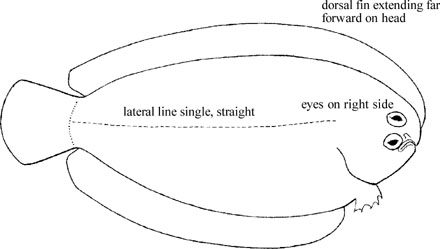SOLEIDAE
Soles
By Keiichi Matsuura
 Pardachirus pavoninus |
|
|
Body oval, strongly compressed, reaching to 32 cm. Eyes on right side of head. Preopercle without free margin, embedded in skin. Mouth small and asymmetrical; snout sometimes hook-shaped. Teeth small, villiform, better developed on blind side jaws. Fins lacking spines. Dorsal fin originating in front of upper eye. Dorsal and anal fins separate from, attached to, or joined to caudal fin. Pectoral fins sometimes absent, when present, right side pectoral fin usually longer than the left side. Pelvic fins sometimes asymmetrical, either free or joined to anal fin. Scales relatively large, cycloid or ctenoid, sometimes modified into skin flaps fringed with sensory filaments. A single lateral line running straight on body, sometimes branched on head. Color: highly variable according to substratum; uniformly brown to brightly colored with scattered dark spots or blotches, or dark bands on eyed side of body; blind side usually whitish or yellowish.
Similar families occurring in the area. Bothidae, Citharidae, Paralichthyidae, Pleuronectidae, and Psettodidae: margin of preopercle free and distinct, not embedded in skin. Cynoglossidae: eyes on left side of head and a rostral hook usually present; usually only 1 pelvic fin; pectoral fins always absent; dorsal and anal fins always joined to caudal fin. Remarks. Inhabit muddy and sandy bottoms in coastal areas. |

|
|